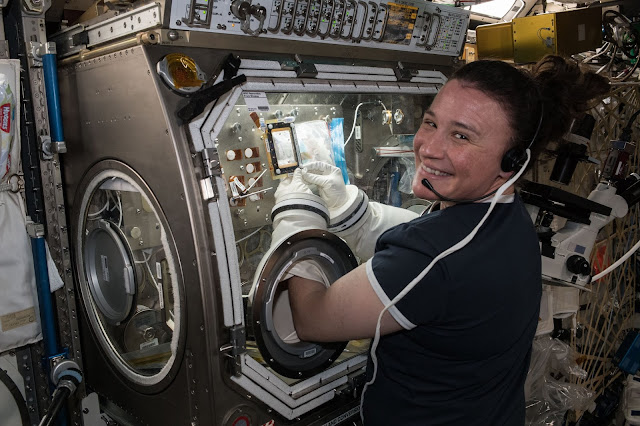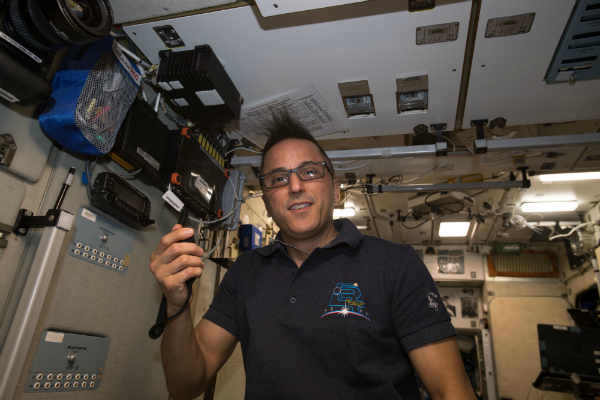ISS - International Space Station logo.
Feb. 13, 2019
During 2018, crew members of Expeditions 54-58 supported more than 100 new U.S. science investigations aboard the International Space Station. Research sponsored by the U.S. National Laboratory in this unique orbiting laboratory advances future missions to the Moon and Mars and improves life on Earth. In February, astronauts set a new record-setting week of research that surpassed 100 hours.
Here's a look back at just some of the science highlights from this year.
1.
Targeted cancer therapies explored
NASA astronaut Serena Auñón-Chancellor conducted research operations for the AngieX Cancer Therapy study inside the Microgravity Science Glovebox (MSG). This research examines whether endothelial cells cultured in microgravity can serve as a valid model to test a safer, more effective treatment that targets tumor cells and blood vessels.
2.
The ups and downs of spaceflight
Alexander Gerst of the European Space Agency (ESA) strapped in for the GRASP investigation. It uses virtual reality to examine how the central nervous system integrates information from the brain and body to coordinate hand movements within the visual environment. The absence of traditional “up” and “down” in microgravity requires the brain to adapt during spaceflight, and researchers want to better understand whether and how gravity acts as a reference when a person reaches out to grasp an object. This investigation also may shed light on the physiology of eye-hand coordination and more effective treatments for loss of vestibular function or balance on Earth.
3.
Station cameras capture storm below
Cameras on the outside of the space station captured the impressive breadth of Hurricane Florence on Sept. 12 as it churned across the Atlantic, heading west-northwest and packing winds of 130 miles an hour. Florence made landfall near Wrightsville Beach, North Carolina at 7:15 a.m. EDT September 14, as a Category 1 storm. The space station offers a unique vantage for observing Earth using both hands-on and automated equipment.
4.
Microbes identified on space station
After swabbing designated surfaces of the space station to collect microbe samples, NASA astronaut Ricky Arnold used the Miniature Polymerase Chain Reaction (miniPCR) to extract RNA from the samples, and sequenced the RNA with the Biomolecule Sequencer for the BEST investigation. In addition to demonstrating for the first time that it is possible to sequence RNA isolated directly from an organism in space, BEST tested the use of sequencing to identify microbial organisms on the space station. The investigation also helps scientists better understand how humans, plants and microbes adapt to life in space.
5.
Space gardeners work to enable self-sufficiency on future flights
The space station’s Veggie Facility, tended here by NASA astronaut Scott Tingle, had growth in two of its units for the first time during the VEG-03 plant growth investigation. Veg-03 cultivated Extra Dwarf Pak Choi, Red Russian Kale, Wasabi mustard, and Red Lettuce and harvested on-orbit samples for testing back on Earth. On future long-duration space missions, crew members need to grow their own food, and understanding how plants respond to microgravity is an important step toward that goal.
6.
Free-flying robots test automated strategies
JAXA astronaut Norishige Kanai conducted a test run of the SPHERES Tether Slosh experiment in the Kibo Japanese Experiment Pressurized Module (JEM). In space, liquid in spacecraft can slosh around in unpredictable ways and complicate space maneuvers. This investigation used fluid dynamics equipment and robotic capabilities aboard the space station to test automated strategies for steering spacecraft containing passive fluid cargo.
7.
Satellite uses camera to track orbital debris
The NanoRacks Remove Debris Satellite, the largest satellite deployed from the Japanese Experiment Module Airlock (JEMAL), floats free from the space station. Collisions with space debris or “space junk” can have serious consequences. Research has shown that removing the largest debris significantly reduces the chance of such collisions. Remove Debris tested technologies to use a 3D camera to map the location and speed of debris and a net to capture and de-orbit simulated debris.
8.
Investigation studies the gut in space
For the Rodent Research-7 (RR-7) experiment, NASA astronaut Drew Feustel took measurements from mice inside the MSG using the Mass Measurement Device, which can quickly measure the mass of objects in the range of 1 to 100 grams in microgravity. RR-7 examines how the space environment affects the community of microorganisms in the gastrointestinal tract of mice, known as the gut microbiota. It also looks at microgravity’s effects on physiological systems known to be affected by the microbiota, including the gastrointestinal, immune, metabolic, circadian, and sleep systems.
9.
Hot science tests may improve fuels for use in space and on Earth
Arnold prepped the Combustion Integrated Rack (CIR), which supports ongoing microgravity combustion research operations, including Cool Flames, FLEX, FLEX-2 and FLEX-2J. Understanding how fuels burn in microgravity supports development of more efficient fuel for interplanetary missions, reducing cost and weight and improving safety. This knowledge also could lead to improved fuels for vehicles and aircraft on Earth, including efficient, environmentally friendly mixtures of chemicals that burn well and produce less soot.
10.
NICER studies pulsars as future navigation tool
This image, taken by the ground-controlled External High Definition Camera 1 (EHDC1), shows the Neutron Star Interior Composition ExploreR (NICER) payload attached outside the space station. Neutron stars, remnants of supernovas, are the densest objects in the universe and contain exotic states of matter impossible to replicate in any lab. They are known as pulsars because they appear to pulse like lighthouse beacons. NICER studies the extraordinary physics of these stars, providing new insights into their nature and behavior and paving the way for future spacecraft navigation anywhere in the solar system using pulsars as natural beacons.
11.
Crew member sleeping habits tested
The sensor taped to Kanai’s forehead collects data for the Circadian Rhythms investigation, which looks at how an individual’s synchronized daily rhythms, or “biological clock,” changes during the non-24-hour cycle of light and dark that crew members experience in space. The investigation also addresses how other conditions experienced in spaceflight affect the biological clock in an effort to improve crew performance and health on future exploration missions.
12.
Investigation studies effects of reduced mobility
Auñón-Chancellor prepared air sample collection hardware for the MARROW experiment. This research looks at the effect of microgravity on bone marrow. The potential negative effect of microgravity on bone marrow and the blood cells that are produced in it has implications for future space travel. On Earth, these effects are similar to those found in people who spend prolonged time in bed, have reduced mobility, or who are aging. A better understanding of the relationship between fat cells and blood-producing cells in the bone marrow also could help improve the health of people on Earth.
13.
Kibo laboratory enables science crossing multiple disciplines
The Japan Aerospace Exploration Agency (JAXA) Kibo laboratory module photographed as the space station orbited over the southern Pacific Ocean east of New Zealand. Visible are its pressurized module and exposed facility, logistics module, remote manipulator system, and inter-orbit communication system unit. Among the multiple investigations these facilities support is Monitor of All-sky X-ray Image (MAXI), which conducted a systemic survey of the entire sky for galactic transient phenomena. Its discoveries include new black hole candidates, more than 20 binary X-ray pulsar outbursts, X-ray flares from 12 stars, and the first observation of the instant that a massive black hole swallowed a star. Since its activation, half of all new black hole candidates have been discovered by MAXI. The investigation released a catalog for high Galactic-latitude sky sources and revealed the existence of a hypernova remnant estimated to be 3 million years old, perhaps the first in our galaxy.
14.
Self-assembling particles tested in fluid medium
Gerst conducted operations for the ACE-T-7 experiment. ACE-T-7 involves the design and assembly of complex three-dimensional structures, known as self-assembled colloidal structures, from small particles suspended within a fluid medium. Microgravity provides insight into the relationship between particle shape and interactions with other particles on this assembly. These fundamental condensed matter concepts are vital to the design of advanced optical materials and active devices.
15.
New methods for growing plants in space
Arabidopsis plants grow in the Plant Habitat-01 experiment growth chamber behind Russian cosmonaut and flight engineer Sergey Prokopev. PH-01 compares differences in genetics, metabolism, photosynthesis, and gravity sensing between plants grown in space and on Earth, and could provide key insights on major changes that occur in plants exposed to microgravity. Understanding how plants respond will help crews on future missions grow plants for food and to generate oxygen.
16.
Improved solidification techniques for life on other planets
Scientists have conducted a number of studies of the potential to make and use concrete on extraterrestrial bodies, such as Mars or the Moon, but understanding how cement solidifies in microgravity is essential to such use. Auñón-Chancellor and fellow NASA astronaut Anne McClain inserted samples into a centrifuge for the MVP-05 investigation, which examines the microstructure of concrete solidified on the space station. This information could also improve processing for the use of concrete on Earth.
17.
Students, teachers and families connect to space station using ham radio
An important part of the space station’s mission is engaging with and inspiring students through educational activities. NASA astronaut Joe Acaba conducted a ham radio session, one of hundreds that have been held as part of the ARISS project. Students selected for the program learn about the space station, radio waves, and other topics and then schedule a ham radio call to ask questions directly to a crew member orbiting 250 miles above them. Hundreds of other students, teachers and families listen in from classrooms or auditoriums.
18.
California wildfires captured by station cameras
An image taken from the space station in August shows wildfires to the north of the San Francisco Bay Area in northern California’s Mendocino National Forest. Images from Crew Earth Observations have contributed to scientific research on urban vegetation, coral reefs, algal blooms, night-time remote sensing, impervious surfaces detection, and breaking Antarctic ice shelves. Scientists have also used them to inventory river sediments and capture sprites, or Transient Luminous Events (TLEs), triggered by large lightning storms. Anyone can use these publicly available images for educational, entertainment, or scientific purposes.
Related links:
U.S. National Laboratory: https://www.issnationallab.org/
AngieX: https://www.nasa.gov/mission_pages/station/research/experiments/explorer/Investigation.html?#id=7502
Microgravity Science Glovebox (MSG): https://www.nasa.gov/mission_pages/station/research/experiments/explorer/Facility.html?#id=341
GRASP: https://www.nasa.gov/mission_pages/station/research/experiments/explorer/Investigation.html?#id=2038
Observing Earth: https://www.nasa.gov/mission_pages/station/research/benefits/observation.html
Biomolecule Sequencer: https://www.nasa.gov/mission_pages/station/research/experiments/explorer/Investigation.html?#id=1917
BEST: https://www.nasa.gov/mission_pages/station/research/experiments/explorer/Investigation.html?#id=7687
VEG-03: https://www.nasa.gov/mission_pages/station/research/experiments/explorer/Investigation.html?#id=1159
SPHERES Tether Slos: https://www.nasa.gov/mission_pages/station/research/experiments/explorer/Investigation.html?#id=7381
Remove Debris: https://www.nasa.gov/mission_pages/station/research/experiments/explorer/Investigation.html?#id=7350
Rodent Research-7 (RR-7): https://www.nasa.gov/mission_pages/station/research/experiments/explorer/Investigation.html?#id=7425
Combustion Integrated Rack (CIR): https://www.nasa.gov/mission_pages/station/research/experiments/explorer/Facility.html?#id=317
Cool Flames: https://www.nasa.gov/mission_pages/station/research/experiments/explorer/Investigation.html?#id=1688
FLEX: https://www.nasa.gov/mission_pages/station/research/experiments/explorer/Investigation.html?#id=655
FLEX-2: https://www.nasa.gov/mission_pages/station/research/experiments/explorer/Investigation.html?#id=470
FLEX-2J: https://www.nasa.gov/mission_pages/station/research/experiments/explorer/Investigation.html?#id=1077
Neutron Star Interior Composition ExploreR (NICER): https://www.nasa.gov/mission_pages/station/research/experiments/explorer/Investigation.html?#id=1705
Circadian Rhythms: https://www.nasa.gov/mission_pages/station/research/experiments/explorer/Investigation.html?#id=869
MARROW: https://www.nasa.gov/mission_pages/station/research/experiments/explorer/Investigation.html?#id=1673
MAX: https://www.nasa.gov/mission_pages/station/research/experiments/explorer/Investigation.html?#id=593
ACE-T-7: https://www.nasa.gov/mission_pages/station/research/experiments/explorer/Investigation.html?#id=1708
Self-assembled colloidal structures: https://www.nasa.gov/feature/investigation-seeks-to-create-self-assembling-materials
Plant Habitat-01: https://www.nasa.gov/mission_pages/station/research/experiments/explorer/Investigation.html?#id=2032
MVP-05: https://www.nasa.gov/mission_pages/station/research/experiments/explorer/Investigation.html?#id=7874
ARISS: https://www.nasa.gov/mission_pages/station/research/experiments/explorer/Investigation.html?#id=337
Crew Earth Observations: https://www.nasa.gov/mission_pages/station/research/experiments/explorer/Investigation.html?#id=84
Space Station Research and Technology: https://www.nasa.gov/mission_pages/station/research/index.html
International Space Station (ISS): https://www.nasa.gov/mission_pages/station/main/index.html
Images, Text, Credits: NASA/Michael Johnson/JSC/International Space Station Program Science Office/Melissa Gaskill.
Best regards, Orbiter.ch



















